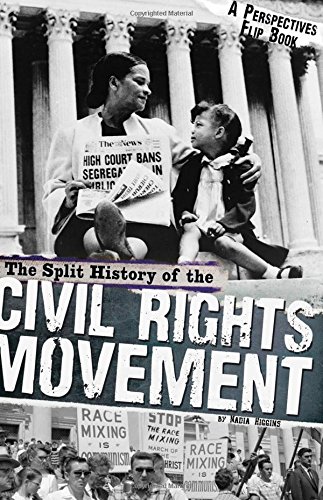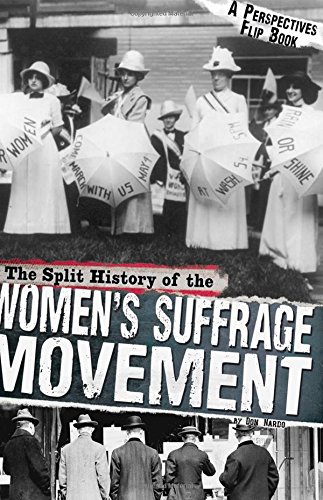-
The Split History of the American Revolution: A Perspectives Flip Book
Michael Burgan, Lawrence Babits
Paperback (Compass Point Books, Aug. 1, 2012)People from Great Britain came to North America to start new lives in the 13 American colonies. In the beginning colonists accepted British rule without question. But by the mid-1700s, things were changing. Many colonists wanted the right to govern themselves. The British government felt as if the colonists were being ungrateful. By 1775 war between the two sides was inevitable. X
X
-
The Split History of Westward Expansion in the United States: A Perspectives Flip Book
Nell Ann Musolf, Malcolm J. Rohrbough
Paperback (Compass Point Books, Aug. 1, 2012)American Indians had lived in North America for thousands of years by the time European settlers arrived. The settlers came in search of land and were eager to build farms, roads, and towns. The Indians lived off the land and believed it belonged to everyone. When the U.S. government completed the Louisiana Purchase in 1803, the plan to expand the country to the Pacific Ocean set up a collision course between the two groups' ways of life. X
X
-
The Split History of World War I: A Perspectives Flip Book
Michael Burgan, Timothy Solie
Paperback (Compass Point Books, Aug. 1, 2013)Tensions have been brewing in Europe for years. Finally the 1914 assassination of Archduke Franz Ferdinand of Austria-Hungary sets off four bloody years of war that eventually involved the entire world, including the United States. It will be called the "war to end all wars." Experience it from two opposing perspectives. X
X
-
The Split History of the Battle of Gettysburg: A Perspectives Flip Book
Stephanie Fitzgerald
Paperback (Compass Point Books, Aug. 1, 2013)It's July 1863. The Civil War is at a turning point. The Confederacy has won some important battles, despite having fewer soldiers and resources than the Union does. The two great armies are marching to the same rural fields near the small town of Gettysburg, Pennsylvania. What will happen there could change the course of the war -- and the future of the United States. Experience the battle as seen from both sides. X
X
-
The Split History of World War II: A Perspectives Flip Book
Simon Rose, Timothy Solie
Paperback (Compass Point Books, Aug. 1, 2012)When World War I ended in 1918, it was called, "the war to end all wars." But it wasn't. Unsettled issues and resentments festered for the next 20 years, culminating in the outbreak of war in Europe and Asia in the 1930s. The Axis powers, led by Germany, Italy, and Japan, joined to fight the Allies, led by the U.S., the United Kingdom, and the Soviet Union. Both sides were determined to rule the world, but only one can succeed. Z
Z
-
The Split History of the Civil War: A Perspectives Flip Book
Stephanie Fitzgerald, Mark Snell
Paperback (Compass Point Books, Aug. 1, 2012)In 1861 the United States was at a crossroads. People in the Southern states believed that Northerners were trying to change their way of life. People in the North were upset that Southerners wanted to govern themselves. The issue of slavery was caught in the middle. As the events of the Civil War unfolded, each side fought for what they believed in. X
X
-
The Split History of the Civil Rights Movement: A Perspectives Flip Book
Nadia Higgins
Paperback (Compass Point Books, Feb. 1, 2014)In the 1950s, a black man in the South was expected to lower his eyes when he passed a white man on the street. African-American and white citizens attended separate schools, restaurants, and parks. They were even buried in separate graveyards. That was how traditional Southern society had been for more than 300 years but times were changing. Civil rights workers were demanding equal rights for blacks. The nonviolent activists boycotted buses, flouted Jim Crow laws, staged marches, and filled up jails by the dozen. Meanwhile, the Klu Klux Klan and other white segregationists retaliated with their own protests, harsher laws, and increasingly violent attacks. The Split History of the Civil Rights Movement brings alive both sides of the civil rights movement. Learn about key figures and the strategies of the movement. Then flip the book for the lesser-known story of the segregationists and the motives that spurred their actions.
-
The Split History of the Women's Suffrage Movement: A Perspectives Flip Book
Don Nardo
Paperback (Compass Point Books, Feb. 1, 2014)In the mid 19th century, a few women living in upstate New York decided it was time for women to stop accepting their status as second class citizens. Women lacked many basic civil rights that men enjoyed, including suffrage the right to vote. These women from New York held a convention in which they demanded their rights. Their battle took more than 70 years to win. Along the way they were opposed and mocked by male and female anti suffragists who tried to stifle their efforts. X
X
-
The Split History of the Women's Suffrage Movement: A Perspectives Flip Book
Don Nardo
Hardcover (Compass Point Books, Jan. 1, 2014)In the mid 19th century, a few women living in upstate New York decided it was time for women to stop accepting their status as second class citizens. Women lacked many basic civil rights that men enjoyed, including suffrage the right to vote. These women from New York held a convention in which they demanded their rights. Their battle took more than 70 years to win. Along the way they were opposed and mocked by male and female anti suffragists who tried to stifle their efforts. X
X
-
The Split History of the American Revolution: A Perspectives Flip Book
Michael Burgan, Lawrence Babits
Library Binding (Compass Point Books, Aug. 1, 2012)People from Great Britain came to North America to start new lives in the 13 American colonies. In the beginning colonists accepted British rule without question. But by the mid-1700s, things were changing. Many colonists wanted the right to govern themselves. The British government felt as if the colonists were being ungrateful. By 1775 war between the two sides was inevitable. X
X
-
School Lunches: Healthy Choices vs. Crowd Pleasers
Amanda Lanser
Paperback (Compass Point Books, Jan. 1, 2015)Childhood obesity is a worsening problem across the country. Will mandating that schools serve healthier lunches help control the problem? Or should children and their parents have the right to choose and learn to make their own healthy choices? Perspectives Flip Books are like two books in one: Start from one end and learn why some people argue schools should ban junk food and serve healthier lunches. Then flip it over and discover why others argue students should make their own choices. Critical thinking questions help you analyze both perspectives and form your own opinions about the issue. X
X
-
The Split History of World War II: A Perspectives Flip Book
Simon Rose, Timothy Solie
Library Binding (Compass Point Books, Aug. 1, 2012)When World War I ended in 1918, it was called, "the war to end all wars." But it wasn't. Unsettled issues and resentments festered for the next 20 years, culminating in the outbreak of war in Europe and Asia in the 1930s. The Axis powers, led by Germany, Italy, and Japan, joined to fight the Allies, led by the U.S., the United Kingdom, and the Soviet Union. Both sides were determined to rule the world, but only one can succeed. Z
Z